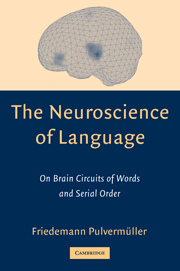Book contents
- Frontmatter
- Contents
- Preface
- The Neuroscience of Language
- 1 A Guide to the Book
- 2 Neuronal Structure and Function
- 3 From Classic Aphasia Research to Modern Neuroimaging
- 4 Words in the Brain
- Excursus E1 Explaining Neuropsychological Double Dissociations
- 5 Regulation, Overlap, and Web Tails
- 6 Neural Algorithms and Neural Networks
- 7 Basic Syntax
- 8 Synfire Chains as the Basis of Serial Order in the Brain
- 9 Sequence Detectors
- 10 Neuronal Grammar
- 11 Neuronal Grammar and Algorithms
- Excursus E2 Basic Bits of Neuronal Grammar
- Excursus E3 A Web Response to a Sentence
- 12 Refining Neuronal Grammar
- Excursus E4 Multiple Reverberation for Resolving Lexical Ambiguity
- Excursus E5 Multiple Reverberations and Multiple Center Embeddings
- 13 Neurophysiology of Syntax
- 14 Linguistics and the Brain
- References
- Abbreviations
- Author Index
- Subject Index
12 - Refining Neuronal Grammar
Published online by Cambridge University Press: 15 December 2009
- Frontmatter
- Contents
- Preface
- The Neuroscience of Language
- 1 A Guide to the Book
- 2 Neuronal Structure and Function
- 3 From Classic Aphasia Research to Modern Neuroimaging
- 4 Words in the Brain
- Excursus E1 Explaining Neuropsychological Double Dissociations
- 5 Regulation, Overlap, and Web Tails
- 6 Neural Algorithms and Neural Networks
- 7 Basic Syntax
- 8 Synfire Chains as the Basis of Serial Order in the Brain
- 9 Sequence Detectors
- 10 Neuronal Grammar
- 11 Neuronal Grammar and Algorithms
- Excursus E2 Basic Bits of Neuronal Grammar
- Excursus E3 A Web Response to a Sentence
- 12 Refining Neuronal Grammar
- Excursus E4 Multiple Reverberation for Resolving Lexical Ambiguity
- Excursus E5 Multiple Reverberations and Multiple Center Embeddings
- 13 Neurophysiology of Syntax
- 14 Linguistics and the Brain
- References
- Abbreviations
- Author Index
- Subject Index
Summary
This chapter takes the concept of a neuronal grammar developed earlier as a starting point. The earlier proposal is partly revised and extended to cope with problems put forth by natural language phenomena.
The three phenomena considered here are as follows:
The distinction between a constituent's obligatory complements and its optional adjuncts.
The multiple occurrence of the same word form in a string.
The embedding of sentences into other sentences.
All three issues have been addressed occasionally before; however, they were not treated systematically in the context of neuronal grammar. This requires its own discussion because the necessary extensions lead to a substantial revision of the previous concept of neuronal grammar.
The gist of the revision briefly in advance is as follows: In earlier chapters, the relationship between sequence detectors and words in the input was assumed to be static. The word web ignites and then, successively, one set of its sequence detectors is recruited according to relationships the word exhibits to words in its context, as they are manifest in regular co-occurrence of lexical category members. Each word would recruit one of its connected lexical category representations. However, if each word form were attributed to one lexical category, it would be impossible to model the situation in which one word occurs twice in different grammatical roles in a sentence.
- Type
- Chapter
- Information
- The Neuroscience of LanguageOn Brain Circuits of Words and Serial Order, pp. 235 - 249Publisher: Cambridge University PressPrint publication year: 2003



